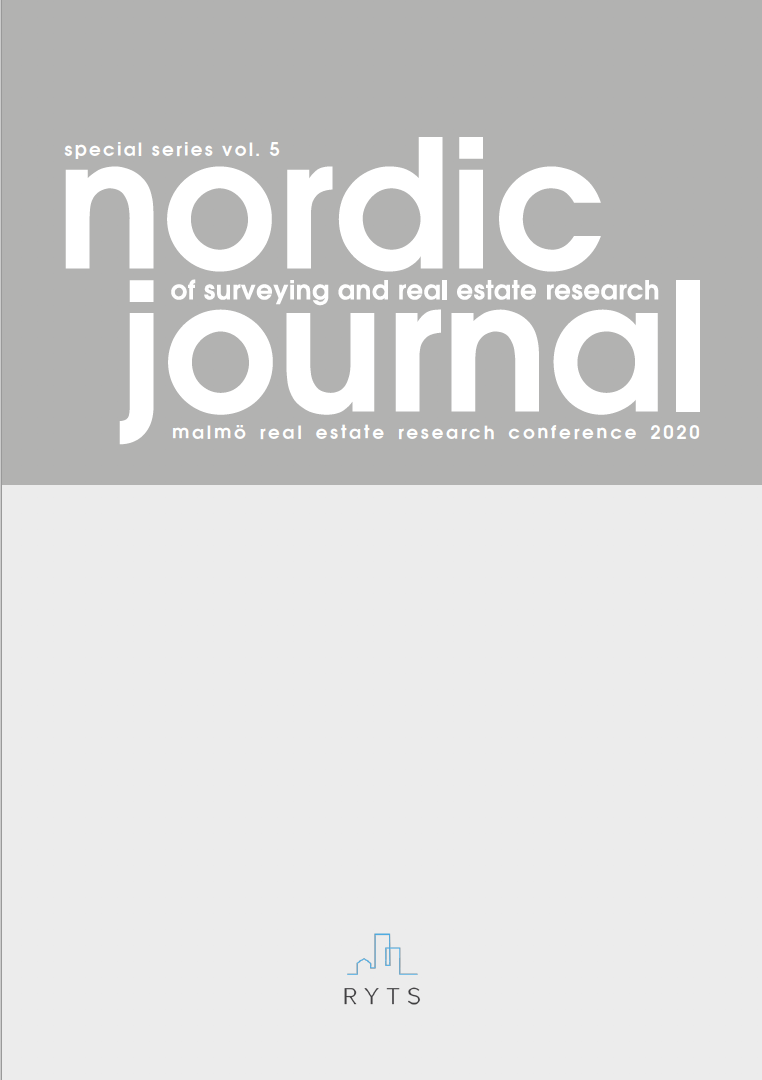Impacts of shopping malls on apartment prices: the case of Stockholm
DOI:
https://doi.org/10.30672/njsr.95437Keywords:
hedonic, spillover effect, shopping mallAbstract
Shopping malls, as an important type of commercial facilities, are growing dramatically. They have gradually become one of the most dominant factors that can influence people's daily life as well as a city's economic development. People's willingness to pay for dwellings is also primarily associated with the surrounding commercial layout. Hence, it is of interest to find out more from a quantitative perspective on the relationship between shopping malls and housing prices. This study aims to analyze how the prices of condominiums will be affected by the proximity of shopping malls. Two aspects are considered and examined in the empirical study, namely a proximity to the shopping mall, and the number of shopping malls within 3 kilometers radius. We try to examine if there is any price premium for those apartments near the shopping mall or with more shopping malls in the neighborhood. In this empirical study, 36 shopping malls in different locations in the county of Stockholm, Sweden, is utilized. The sample of transactions consists of 336,914 apartments. By using regression analysis, based on the traditional hedonic model, the results show that there is an inverse relationship between the apartment prices and its distance from the shopping mall while the number of shopping malls is positively correlated with apartment prices. However, the impact has declined over time.
References
Berk, R. A. (1990). A primer on robust regression. In Modern Methods of Data Analysis, ed. J. Fox and J. S. Long, 292–324. Newbury Park, CA: Sage. 1990.
Brunes, F., Hermansson, C., Song, H. S., & Wilhelmsson, M. (2020). NIMBYs for the rich and YIMBYs for the poor: analyzing the property price effects of infill development. Journal of European Real Estate Research. 13(1), 55-81.
Carter, C. (2009). What We Know About Shopping Centers. Journal of Real Estate Literature, 17(2), 165-180.
Chau, K. W., Chin, T. L. (2003). A critical review of literature on the hedonic price model. International Journal for Housing Science and Its Applications, 27(2), 145-165
Colwell, P. F., Gujral, S. S., Coley, C. (1985). The impact of a shopping center on the value of surrounding properties. Real Estate Issues, 10(1), 35-39.
Deaton, B. Hoehn, J. (2004). Hedonic analysis of hazardous waste sites in the presence of other urban disamenities. Environmental Science & Policy. 7. 499-508. 10.1016/j.envsci.2004.08.003.
Des Rosiers, F., Lagana, A., Thériault, M., Beaudoin, M. (1996), "Shopping centres and house values: an empirical investigation", Journal of Property Valuation and Investment, Vol. 14 No. 4, pp. 41-62.
Erkip, F. (2005). The rise of the shopping mall in Turkey: The use and appeal of a mall in Ankara. Cities, 22(2), 89-108.
Fasli, M., Riza, M., Erbilen, M. (2016). The assessment and impact of shopping centers: case study lemar. Open House International, 41(4), 98-103.
Gareth, J., Witten, D., Hastie, T., Tibshirani, R. (2017). An Introduction to Statistical Learning (8th ed.). Springer Science+Business Media New York. ISBN 978-1-4614-7138-7.
Howard, E. (2007), New shopping centres: is leisure the answer?, International Journal of Retail & Distribution Management, Vol. 35 No. 8, pp. 661-672.
Mok, H., Chan, M., & Cho, K. (1995). A hedonic price model for private properties in Hong Kong. The Journal of Real Estate Finance and Economics, 10(1), 37-48.
Monson, M. (2009). Valuation using hedonic pricing models. Cornell Real Estate Review, 7, 62-73.
Morancho, A. (2003). A hedonic valuation of urban green areas. Landscape and Urban Planning, 66(1), 35-41.
Ozuduru, B. (2013). Assessment of Spatial Dependence Using Spatial Autoregression Models: Empirical Analysis of Shopping Center Space Supply in Ohio. Journal of Urban Planning and Development, 139(1), 12-21.
Palmquist, R.B., (2006), Property Value Models in Raymond B. Palmquist (eds.), Handbook of Environmental Economics, vol 2, Elsevier
Rosen, S. (1974). Hedonic Prices and Implicit Markets: Product Differentiation in Pure Competition. Journal of Political Economy, 82(1), 34-55.
Rousseeuw, P., & Leroy, A. (1987). Robust regression and outlier detection (Wiley series in probability and mathematical statistics). New York: Wiley.
Schulz, R., Werwatz, A. A (2004). State Space Model for Berlin House Prices: Estimation and Economic Interpretation. The Journal of Real Estate Finance and Economics 28, 37–57.
Seago, J. (2013). Northgate Mall's effect on surrounding property values. Economics 355 — Urban Economics. Durham Paper. Duke University. North Carolina, USA.
Sirpal, R. (1994). Empirical Modeling of the Relative Impacts of Various Sizes of Shopping Centers on the Values of Surrounding Residential Properties, Journal of Real Estate Research, vol. 9(4), pages 487-506.
Statistics Sweden. (2019). Population. Retrieved from https://www.scb.se/en/finding-statistics/statistics-by-subject-area/population
Walsh, P.J., Milon, J.W., Scrogin, D.O. (2012). The Spatial Extent of Water Quality Benefits in Urban Housing Markets. Land Economics 87(4), 628-644.
Wang, R., Li Ye, Liwen Chen. (2019). The Impact of High-Speed Rail on Housing Prices: Evidence from China's Prefecture-Level Cities. Sustainability, 11(13), 3681.
Wilhelmsson, M. (2002). Spatial models in real estate economics, Housing, Theory and Society, 19 (2), 92–101.
Wilhelmsson, Mats (2019). Energy performance certificates and its capitalization in housing values in Sweden, Sustainability, 11, 6101; doi:10.3390/su11216101.
Wooldridge, J.M. (2006). Introductory Econometrics: A Modern Approach, 3rd ed. Thomson South-Western, Mason, OH.
Zhang, L., Zhou, J., Hui, E. C. M., Wen, H. (2019). The effects of a shopping mall on housing prices: A case study in Hangzhou. International Journal of Strategic Property Management, 23(1), 65–80.
Downloads
Published
How to Cite
Issue
Section
License
Copyright (c) 2020 Mats Wilhelmsson, Runfeng Long

This work is licensed under a Creative Commons Attribution 4.0 International License.
NJSR is an Open Access journal which means that all content is freely available without charge to the user or their institution. Users are allowed to read, download, copy, distribute, print, search, or link to the full texts of the articles, or use them for any other lawful purpose, without asking prior permission from the publisher or the author. This is in accordance with the BOAI definition of Open Access.
Copyright of published articles remains with the author(s).
Accepted 2020-09-08
Published 2020-11-17


